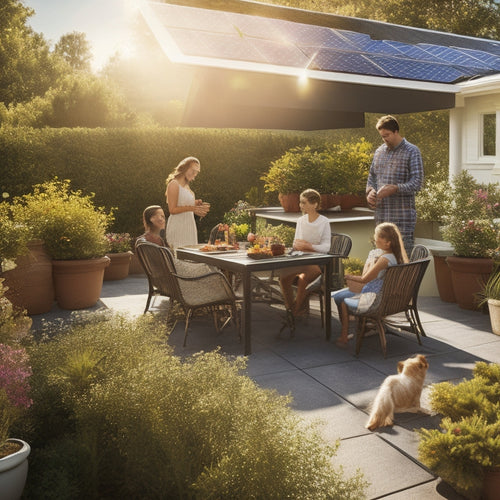
Best Solar Power Systems for Home Energy Savings
Share
When investing in a solar power system for home energy savings, you'll want to contemplate top brands like SunPower and Panasonic for their high-efficiency panels, or Trina and Hanwha Q CELLS for competitively priced options. You'll also need to decide on a system configuration, choosing from grid-tied, off-grid, or hybrid systems, depending on your energy needs and local building codes. Additionally, contemplate inverter types and efficiency, battery backup options, and installation costs. By selecting the right system size and taking advantage of government incentives, you can maximize your energy savings and reduce your carbon footprint. As you weigh your options, you'll want to carefully evaluate the factors that will make your solar power system a success.
Key Takeaways
- Efficient solar panels with high ratings (up to 22.8%) from brands like SunPower and Panasonic can maximize energy savings.
- Grid-tied systems are the most common, allowing homeowners to sell excess energy back to the utility and earn credits.
- Inverters with high efficiency ratings (above 95%) and advanced technologies ensure optimal energy production and savings.
- Battery backup options like lithium-ion and sodium-ion batteries provide reliable energy storage and backup during outages.
- Proper system sizing, installation, and maintenance are crucial to ensure optimal energy savings and a favorable return on investment.
Top Solar Panel Brands
Investigate the top solar panel brands that can help you harness the power of the sun and save on energy costs.
You'll want to evaluate brands that prioritize solar panel efficiency, as this directly impacts the amount of energy you can capture from the sun. Leading brands like SunPower and Panasonic boast high-efficiency solar panels, with some models reaching up to 22.8% efficiency.
Other top brands, such as Trina and Hanwha Q CELLS, offer high-performance panels with competitive pricing. As you investigate your options, keep an eye on emerging solar energy trends, like bifacial panels that can absorb light from both the front and back sides.
These innovative designs can increase energy output by up to 25%. When selecting a solar panel brand, look for certifications like UL and IEC, which guarantee the panels meet rigorous safety and performance standards.
Understanding System Configurations
When you're selecting a solar power system, you'll need to evaluate two key aspects: system design options and grid connection types.
Your system design will depend on factors like your roof's size and orientation, as well as local building codes and regulations.
You'll also need to decide whether you want a grid-tied, off-grid, or hybrid system, each with its own advantages and limitations.
System Design Options
Among the crucial decisions you'll make when shifting to solar power is choosing the right system design option for your home. The type of system you choose depends on your energy needs, budget, and lifestyle. You have three primary system design options to evaluate: grid-tied, off-grid systems, and hybrid solutions.
Grid-tied systems are the most common type, where your solar panels are connected to the grid, and excess energy is sold back to the utility company. Off-grid systems, on the other hand, are ideal for remote locations or those who want complete energy independence. They store excess energy in batteries for later use.
Hybrid solutions offer the best of both worlds, allowing you to store excess energy in batteries while still having a connection to the grid.
When deciding on a system design option, reflect on your energy usage patterns, available roof space, and local building codes. It's crucial to assess your energy needs and choose a system that can meet them efficiently.
Grid Connection Types
Since you've selected a grid-tied system, understanding the grid connection types is essential to maximize your energy savings. Grid connection types determine how your solar power system interacts with the utility grid, affecting your energy independence and renewable integration. You have three primary options: grid-tied, off-grid, and hybrid solutions.
| Connection Type | Description | Benefits |
|---|---|---|
| Grid-Tied | Connects to the grid, selling excess energy back to the utility | Maximizes energy savings, eligible for solar incentives |
| Off-Grid | Isolated from the grid, relying solely on solar power | Achieves complete energy independence, ideal for remote locations |
| Hybrid | Combines grid-tied and off-grid capabilities, providing backup power | Offers utility cooperation and energy independence during outages |
| AC-Coupled | Allows for grid-tied and off-grid operation, with a single inverter | Provides flexibility and compatibility with existing systems |
| DC-Coupled | Enables hybrid operation, with a single inverter and battery bank | Optimizes energy storage and renewable integration |
When selecting a grid connection type, consider your energy goals, location, and utility cooperation. By understanding these options, you can optimize your system configuration and maximize your energy savings.
Inverter Types and Efficiency
You'll want to contemplate the inverter efficiency ratings when selecting a solar power system, as they directly impact the amount of energy your system produces.
Grid tie inverters, which convert DC power from your solar panels to AC power for your home, are a popular choice for residential solar installations.
Inverter Efficiency Ratings
Rated by their efficiency, inverters are the linchpin of a solar power system, converting DC power from the panels into usable AC power for your home.
When selecting an inverter, you'll want to evaluate its efficiency rating, which is typically measured by the California Energy Commission (CEC). The CEC sets efficiency standards for inverter technologies, ensuring they meet certain performance benchmarks.
Here are four key aspects to evaluate when assessing inverter efficiency ratings:
-
Peak Efficiency: This measures the inverter's maximum efficiency, typically occurring at a specific DC input voltage.
-
CEC Efficiency: This is a weighted average of the inverter's efficiency at multiple DC input voltages, providing a more accurate representation of real-world performance.
-
European Efficiency: Similar to CEC efficiency, this standard is used internationally and provides a thorough efficiency rating.
- MPPT Efficiency: This measures the inverter's ability to accurately track the maximum power point of the solar panel array, ensuring ideal energy harvest.
Grid Tie Inverters
Grid tie inverters are the most common type of inverter used in residential solar power systems, as they efficiently convert DC power from your solar panels into AC power that's synchronized with the grid's frequency and voltage. This allows you to feed excess energy back into the grid and offset your energy consumption.
You'll appreciate the advanced inverter technologies that guarantee a high level of grid stability, which is critical for a reliable and efficient energy supply.
When selecting a grid tie inverter, you'll want to take into account factors such as maximum power point tracking (MPPT) and dc-ac conversion efficiency. MPPT guarantees that your inverter is always operating at the ideal power level, while high conversion efficiency minimizes energy losses.
Look for inverters with high efficiency ratings, typically above 95%, to maximize your energy savings. Additionally, take into account inverters with built-in monitoring capabilities, which enable you to track your energy production and consumption in real-time.
Battery Backup Options Explained
As solar energy becomes an increasingly popular choice for homeowners, having a reliable battery backup system in place is crucial to guarantee a steady supply of power during outages or periods of low sunlight.
You need a system that can store excess energy generated by your solar panels during the day and provide power when you need it most.
When it comes to choosing a battery backup system, you have several options to evaluate:
-
Lead-Acid Batteries: A cost-effective option with a long history of use, but with relatively low storage capacity.
-
Lithium-Ion Batteries: A popular choice for solar battery systems due to their high energy density and long lifespan.
-
Sodium-Ion Batteries: A newer, more sustainable option with similar performance to lithium-ion batteries.
- Flow Batteries: Ideal for long-duration energy storage, these batteries are well-suited for homes with high energy demands.
When selecting a battery backup system, you'll want to assess factors such as storage capacity, depth of discharge, and compatibility with your solar panel system.
Installation and Maintenance Costs
Your solar power system is finally installed, and you're ready to start generating clean energy and saving on your utility bills.
Now it's vital to evaluate the installation and maintenance costs associated with your system. While the initial investment may seem intimidating, the installation benefits far outweigh the costs. Not only will you save on energy bills, but you'll also increase your property value and reduce your carbon footprint.
To guarantee your system operates efficiently, regular maintenance is fundamental. Maintenance tips include inspecting your panels regularly for debris and damage, cleaning them periodically, and monitoring your system's performance.
You should also perform routine checks on your inverters, connectors, and wiring to prevent faults. By doing so, you'll minimize the risk of system downtime and optimize energy production.
Additionally, many solar panel manufacturers offer warranties that cover repairs and replacements, providing added peace of mind. By factoring in these costs and following maintenance tips, you'll maximize your energy savings and enjoy a hassle-free solar power experience.
Government Incentives and Rebates
Now that you've taken care of installation and maintenance, it's time to investigate the financial benefits that come with going solar.
One of the most significant advantages of solar power is the government incentives and rebates available to homeowners who make the switch.
You can take advantage of the following incentives to reduce the upfront cost of your solar power system:
-
Federal Tax Credits: You can claim a tax credit of up to 26% of the total cost of your solar power system.
-
Local Rebate Programs: Many local governments and utilities offer rebate programs that can help offset the cost of installation.
-
State Tax Credits: Some states offer additional tax credits for solar power systems, which can be claimed in addition to federal credits.
- Net Metering: You can sell excess energy back to the grid and receive credits on your utility bill, reducing your energy costs even further.
Choosing the Right System Size
Efficiency is key when it comes to maximizing your energy savings with a solar power system. To achieve this, you need to choose the right system size that aligns with your energy consumption. A system that's too small won't cover your energy needs, while an oversized system will waste energy and increase costs.
Calculating your system capacity requires analyzing your energy consumption patterns. Review your past utility bills to determine your average daily energy usage in kilowatt-hours (kWh). Consider factors like the size of your home, number of occupants, and energy-intensive appliances. You can also use online tools or consult with a solar expert to get an accurate assessment.
Once you have a clear illustration of your energy needs, you can determine the ideal system capacity. A typical residential solar power system ranges from 3 to 10 kilowatts (kW). A 5 kW system, for instance, can generate around 500-700 kWh of electricity per month, depending on your location and panel efficiency.
Frequently Asked Questions
Do Solar Panels Work During Power Outages?
You're wondering if solar panels work during power outages - the answer is no, unless you have solar battery storage, which enables grid independence, allowing you to capture and store energy for use during outages.
Can I Install Solar Panels on My Own?
Imagine building a puzzle without instructions - that's DIY solar panel installation. While it's possible, you'll likely void warranties and risk electrical shock. Consider hiring a pro to guarantee a safe, efficient setup, as the cost of mistakes far outweighs the initial savings.
How Do I Clean My Solar Panels Effectively?
You'll maximize energy output by implementing regular solar panel maintenance, utilizing effective cleaning techniques like soft-bristled brushes, mild soap, and distilled water to remove debris, ensuring peak performance and minimizing energy losses.
Are Solar Panels Resistant to Hail and Extreme Weather?
You're likely wondering if solar panels can withstand Mother Nature's fury, and coincidentally, most manufacturers design them to resist hail damage up to 25mm in diameter, ensuring impressive weather durability in extreme conditions.
Can I Add Solar Panels to My Existing Roof Later?
You can add solar panels to your existing roof later, but first, assess your roof's suitability for solar panel integration, considering factors like age, condition, and structural integrity to guarantee a safe and efficient installation.
Conclusion
As you flip the switch to a brighter, more sustainable future, remember that tapping into the sun's power is just the beginning. Your solar power system is the key that opens a treasure chest of energy savings, reduced carbon footprint, and increased property value. With the right system, you'll be shining bright like a guiding light, illuminating the path to a cleaner, greener tomorrow. Now, go ahead and bask in the radiant glow of your smart investment, knowing you've made a difference for generations to come.
Related Posts
-

Solar Power Backup Solutions During Outages
Solar power backup solutions guarantee you have reliable energy during outages, providing essential power when the gr...
-

Long-Term Cost Savings With Solar Panels
Investing in solar panels offers substantial long-term savings on energy costs. You'll benefit from federal tax credi...
-

Cost-Effective Solar Solutions for Rural Homes
Cost-effective solar solutions can alter your rural home by enhancing energy independence and slashing utility bills....


